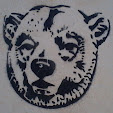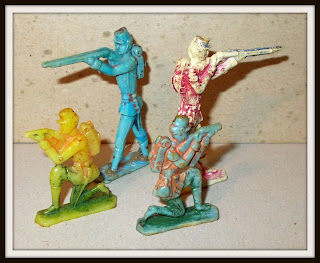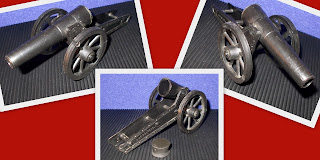. . . a bit of Russian-should-be-Bulgarian stuck on the end of the post!
I received a lovely donation from Grzegorz Maciak the other day, of rare, unusual, new-to-Blog or much needed Polish polymer, which we are to look at right now!
As it arrived; The figure top left is a PZG, from the larger scale sets, probably later production (unpainted) and the officer from the Cold War set, next to him a lovely horse from the PZG set of 'Golden Horde'; those from the era of the Mongol invasions . . . indeed, with both rear feet of the ground, possibly the most dynamic and 'best' horse-pose in the set. Both are believed to be manufactured in Nylon-66.Next to them is what I think is a home-made modelling-clay/craft clay figure of a medieval warrior with his shield slung on his back, the rest are hard polystyrene flats in two sizes/from two sets and from or based-on the German Schneider's home-casting moulds, some marked ZW.
The figure (which you may remember was in a donation from Chris Smith back at the start of lockdown) is the Hetman from the Golden Horde set, I suspect Hetman gives us, or gave us many centuries ago - the terms 'Headman' in English and Hauptman in German, or that they all share a common-root? His horse was much needed!I have somewhere a pot of gold ink (from my days as a calligrapher! Pelican Plaka or something?) which is the same dull shade PZG used, so when I find it I'll try giving them both a heavy dry-brushing to get them back to something of their past glory and get them to match; the original set were all-gold, horses and riders.
The larger flats, originally designed as infantry of the Franco-Prussian war, pass just as well for the uniforms of Russian, East European and Balkan forces in the wars with the Ottomans (and each-other!) in the 1870's - link in a minute. The smaller figures are more WWII/immediate post-war period (if assumed to be Polish Infantry) but are based on the original WWI/Inter-war period German/generics of Schneider's moulds, while the Cavalryman could be Polish, but is wearing a helmet while their 'last ever' cavalry charge was probably conducted with the soft Czapka headdress?A footnote to the previous paragraph - for years Poland claimed the last ever cavalry charge in 1939, but the Australian Light Horse charged the Japanese later in the war, while Cossacks on both sides in the 'Great Patriotic War' will no doubt also have claims to that record - it's not a debate though as the Poles then charged German positions at Schoenfeld in 1945, cementing their claim!
It's the mounted lancers who carry the only mark on all these, a small 'w' sitting on the tail of a larger 'Z'. It could be something as simple as 'Zakład Warsaw' (Warsaw Plant/Factory), but I have no evidence for that or anything else and there is nothing in Garratt's encyclopaedia? The new polystyrene figures compared to the two older soft polyethylene figures Paul (from Moonbase) gave me years ago and which were recalled by Yori as being Polish and - what we now know as - 'Kioskowce', the older two are probably also from Schneider moulds.There is a current Schneider in catering/silicon moulds, but it was only formed in 1977 and has no link to the 1913 Schneider Brothers of flat-mould fame,that I'm aware of. Although - calling all these Schneider is an 'old school' practice, they ceased production before the 2nd World War, and most of the moulds you encounter these days may be/are more likely to be St Louis Lead, Greiner or Agasee to mention the better-known of many inheritors/copyists.
While all the above was going on I managed to pick this up on feebleBay, it's a Russian tourist trinket I think, commemorating the battle of Shipka Pass (which was several battles over some time), where actually the Bulgarians played the greater part in manpower.
It's a large lump of polyethylene with a rubber plug in the breach, as the trunion-bar runs through the barrel and out both sides it's not missing a firing mechanism, so I guess the rubber-plug is original. That bar and three others between the trails are heat-welded closed/shut as are both axle ends so there is a robustness to the chunky thing!
Above are the guns upon which the toys seems to have been based.
Another minor connection with this addition and the preceding shots is that it was in the wars surrounding the Russo-Turkish fight, some earlier, some later, which lead to Poland's loss of independence and partition between Russia, Prussia and Austro-Hungary. Sad face.
And thanks again to Chris Smith, Grzegorz Maciak and Paul 'Woodsy' Woods for all the interesting figure donations!












No comments:
Post a Comment